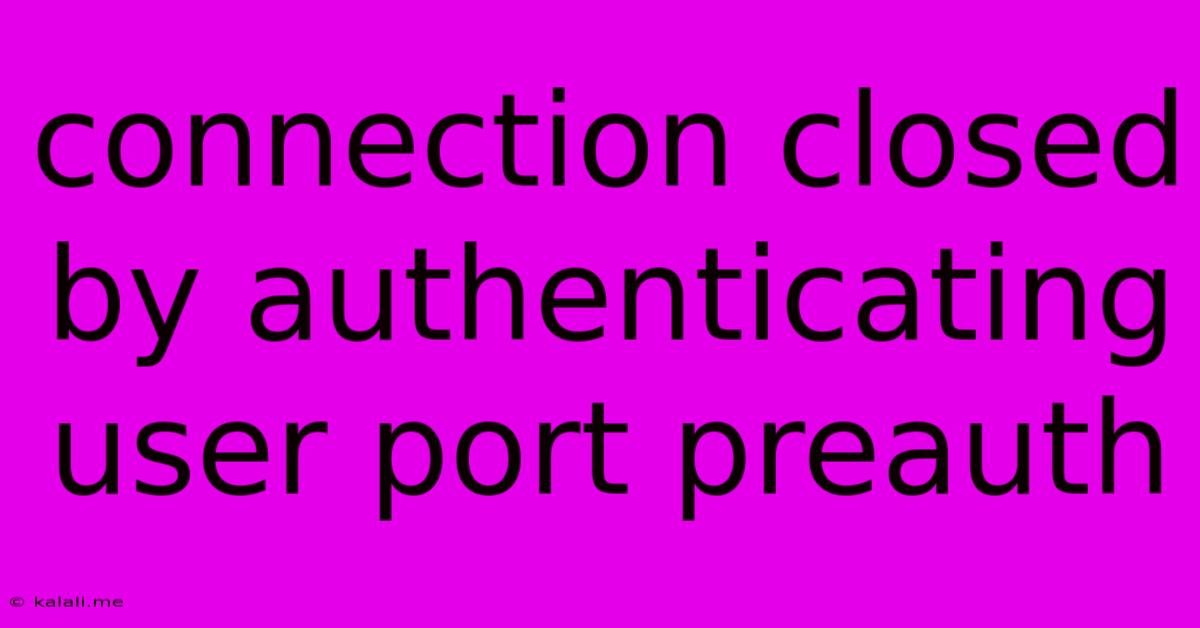Connection Closed By Authenticating User Port Preauth
Kalali
Jun 04, 2025 · 4 min read

Table of Contents
Connection Closed by Authenticating User: Decoding the Port Preauth Mystery
Getting a "Connection closed by authenticating user: port preauth" error message can be frustrating, especially when you're trying to access a crucial service or application. This error typically indicates a problem with the authentication process before the connection is fully established. This article will delve into the root causes of this error, offering practical solutions to help you troubleshoot and resolve the issue.
This enigmatic error message often stems from misconfigurations in network settings, authentication protocols, or even server-side issues. Understanding the underlying causes is key to finding an effective solution.
Understanding the Error: Port Preauthentication
The term "port preauth" refers to a security mechanism where authentication happens before the connection is fully established. This prevents unauthorized access by verifying credentials upfront. When this process fails, the connection is abruptly closed, resulting in the error message. This is a common scenario in various networking environments, including those using VPNs, SSH, or other secure protocols.
Common Causes and Troubleshooting Steps
Several factors can contribute to this error. Let's break down the most frequent causes and how to address them:
1. Incorrect Username or Password:
- Problem: This is the most common cause. A simple typo in your username or password can trigger the error.
- Solution: Double-check your credentials carefully. Ensure you're using the correct capitalization and avoid any extra spaces. If you've recently changed your password, make sure you're using the updated one. Reset your password if needed, following the instructions provided by your service provider.
2. Network Connectivity Issues:
- Problem: Intermittent or unstable network connections can disrupt the authentication process. Firewall restrictions, DNS problems, or temporary network outages can all play a role.
- Solution: Check your internet connection. Try accessing other websites or online services to confirm your internet is working correctly. Restart your modem and router. Temporarily disable any firewalls or antivirus software that might be interfering with the connection. If using a VPN, try disconnecting and reconnecting, or consider using a different VPN server.
3. Server-Side Problems:
- Problem: The server you're trying to connect to might be experiencing temporary outages, maintenance, or configuration issues.
- Solution: Check the status of the server you're trying to access. Look for service announcements or status pages from the provider. If the issue persists, contact the server administrator or technical support.
4. Firewall or Security Software Interference:
- Problem: Your firewall or security software might be blocking the connection attempt, even if the credentials are correct.
- Solution: Temporarily disable your firewall or antivirus software to see if it resolves the issue. If it does, you'll need to configure your security software to allow the connection through. This often involves adding exceptions or rules for the specific port being used.
5. Incorrect Port Number:
- Problem: You might be trying to connect to the wrong port number. Each service or application typically uses a specific port.
- Solution: Verify the correct port number for the service you're attempting to access. Consult the documentation or support resources for the service.
6. Outdated Software or Drivers:
- Problem: Outdated network drivers or client software can lead to compatibility issues and authentication failures.
- Solution: Update your network drivers and the client software you are using to connect to the server.
7. Authentication Protocol Mismatch:
- Problem: There might be a mismatch between the authentication protocol used by the client and the server.
- Solution: Check the authentication settings on both the client and the server. Ensure they are compatible.
Advanced Troubleshooting
If the basic troubleshooting steps don't resolve the issue, you might need to investigate more advanced aspects:
- Check Server Logs: If you have access to the server's logs, examine them for more detailed error messages that might offer clues.
- Network Diagnostics: Use network diagnostic tools to identify any network-related problems like packet loss or latency.
- Consult Documentation: Thoroughly review the documentation for the specific software or service you're using. Look for troubleshooting sections or FAQs that might address similar issues.
By systematically investigating these potential causes and implementing the suggested solutions, you should be able to overcome the "Connection closed by authenticating user: port preauth" error and successfully establish your connection. Remember to always prioritize security best practices while troubleshooting.
Latest Posts
Latest Posts
-
Django Do Print Statements Slow It Down
Jun 05, 2025
-
Can You Put Threadless Fork On Old Road Bike
Jun 05, 2025
-
Safest Way To Hang Bedroom Sheets On Drywall
Jun 05, 2025
-
What Side Of The Tree Does Moss Grow On
Jun 05, 2025
-
Its Generally The Only One That Gets To Grease
Jun 05, 2025
Related Post
Thank you for visiting our website which covers about Connection Closed By Authenticating User Port Preauth . We hope the information provided has been useful to you. Feel free to contact us if you have any questions or need further assistance. See you next time and don't miss to bookmark.